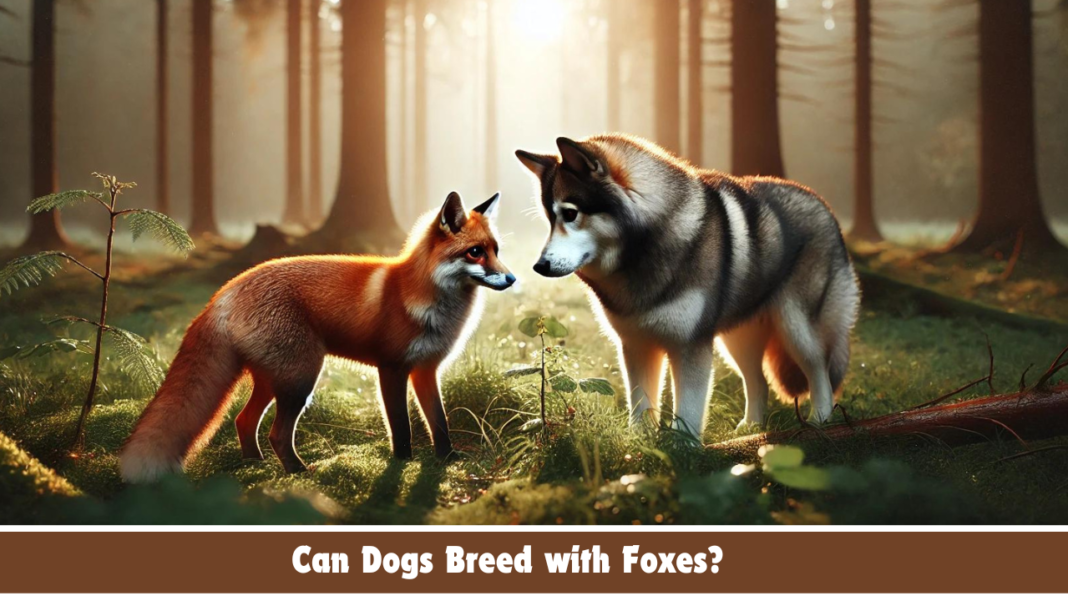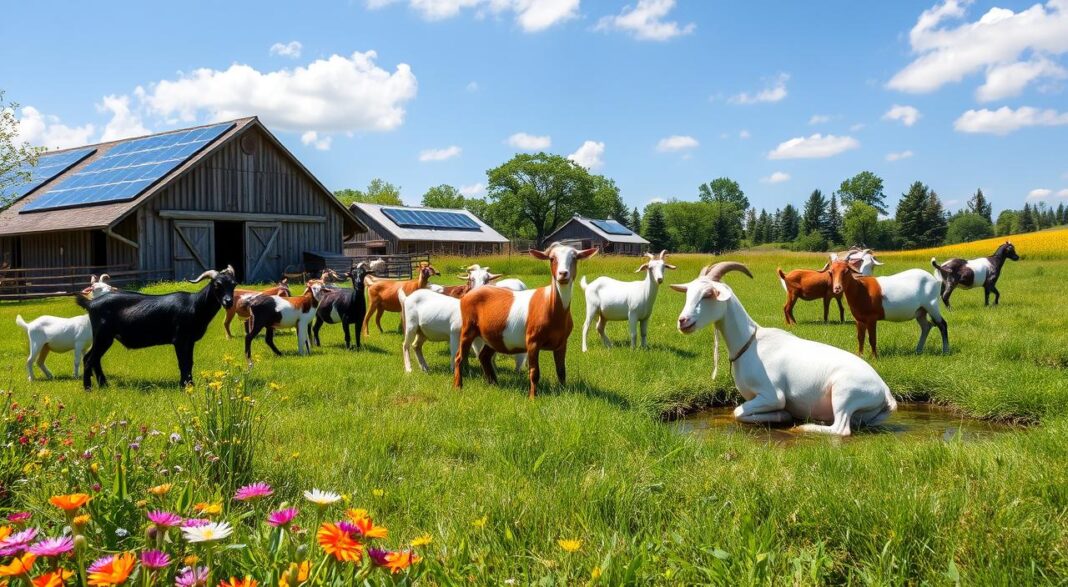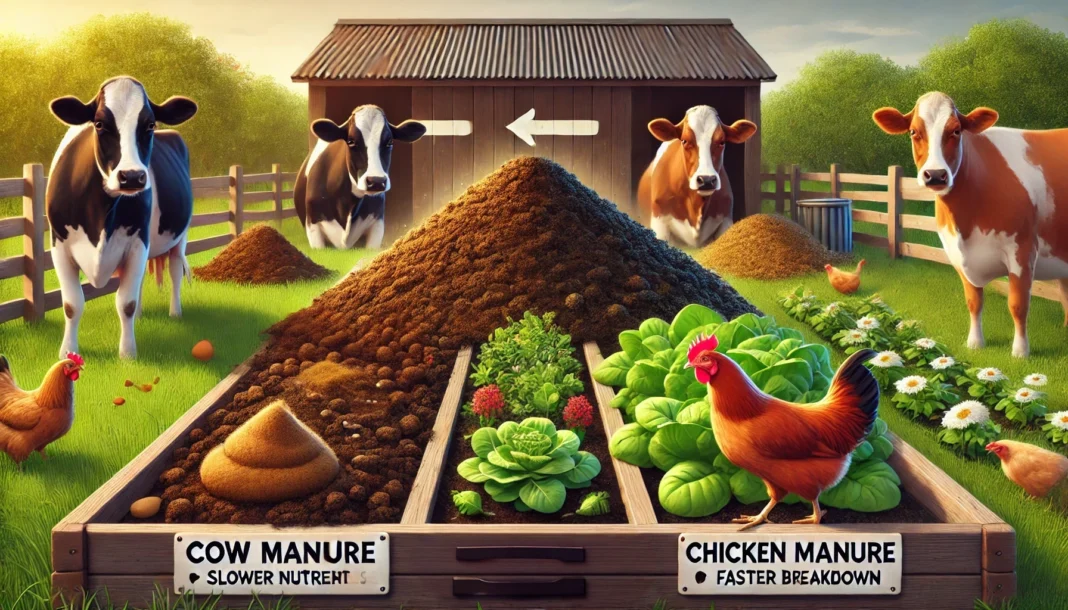Are you curious to know “Can Dogs Breed with Foxes?” Then this blog post is for you.
Dogs and foxes are fascinating animals that belong to the Canidae family. Many wonder if these two species can breed together. Let’s explore the facts and myths about dog-fox breeding.
We’ll look at canid genetics and the barriers to interspecies breeding. We’ll also uncover scientific truths behind this intriguing question.
We’ll examine the differences between dogs and foxes. We’ll also investigate rare cases like the Dogxim, a possible dog-fox hybrid. Finally, we’ll explore the genetic and evolutionary factors that affect cross-breeding chances.
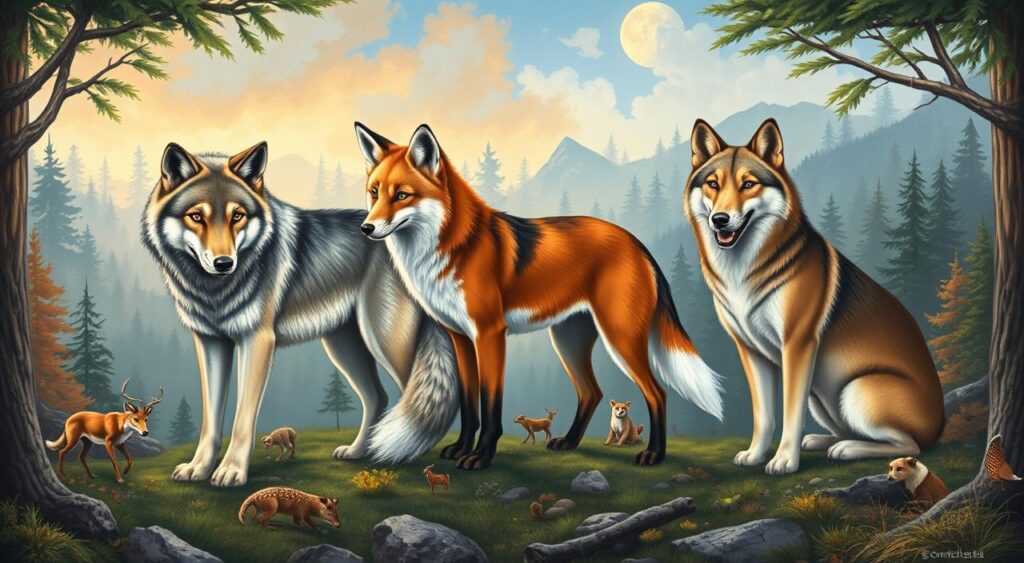
Key Takeaways
- Dogs and foxes belong to the same family, Canidae, but are genetically distinct and separated by millions of years of evolution.
- Taxonomic differences, such as distinct genera and varying chromosome numbers, pose significant barriers to interbreeding between dogs and foxes.
- Evolutionary divergence and reproductive isolation mechanisms further reduce the likelihood of successful dog-fox hybridization in the wild.
- The rare case of Dogxim, a possible dog-fox hybrid discovered in Brazil, raises questions about the potential consequences of interspecies hybridization on native populations and wildlife conservation efforts.
- While myths and misconceptions surrounding dog-fox hybrids persist, scientific evidence suggests that successful interbreeding between these species is highly unlikely under natural conditions.
Introduction to Dog and Fox Breeding
Dogs and foxes belong to the Canidae family. They fascinate animal lovers and researchers alike. People often wonder if dogs can breed with foxes.
The idea of dog-fox offspring has sparked interest. It raises questions about wildlife conservation. Understanding barriers to hybrid fertility is crucial.
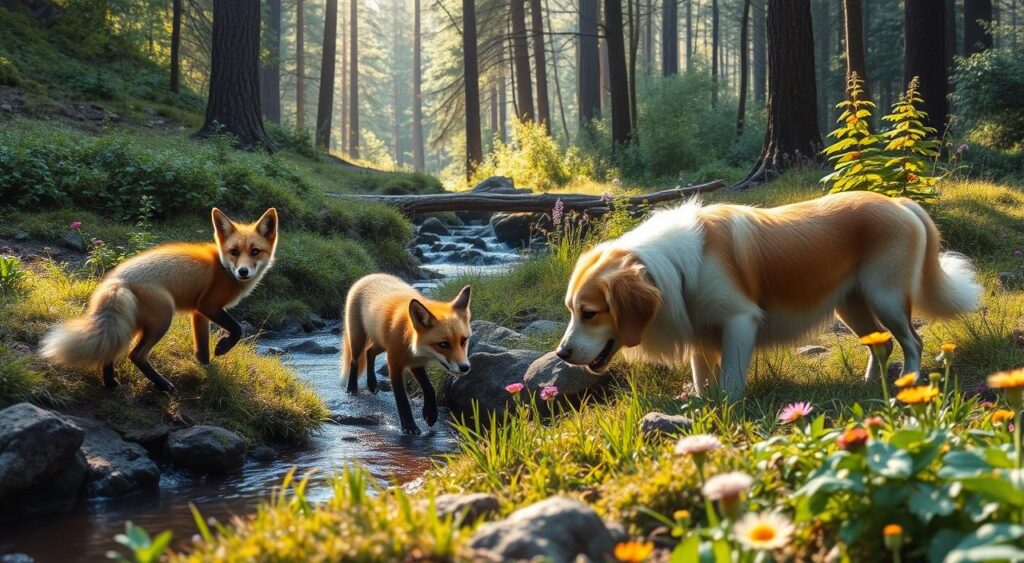
Dogs and foxes have evolved differently over time. This has led to big genetic and taxonomic differences. These differences make interbreeding in the wild unlikely.
Rare cases of dog-fox hybrids have been reported. This raises concerns about crossbreeding’s impact on ecosystems. It also affects species preservation.
We need to look at factors that create species barriers. Understanding hybrid fertility challenges is important. This helps us grasp the chances of dog-fox offspring.
| Species | Genus | Chromosomes |
|---|---|---|
| Dog (Canis lupus familiaris) | Canis | 78 |
| Red Fox (Vulpes vulpes) | Vulpes | 34 |
The table shows key differences between dogs and foxes. Dogs have 78 chromosomes and belong to the Canis genus. Foxes have 34 chromosomes and are in the Vulpes genus.
These differences make interbreeding very difficult. The chromosome mismatch is a big hurdle for creating viable dog-fox offspring.
Dog-fox breeding could impact wildlife conservation efforts. Hybrid animals in natural habitats might alter wild populations’ genetic makeup. They could also spread diseases between species.
We’ll explore scientific evidence about dog-fox hybrids next. We’ll look at case studies and discuss conservation implications. This knowledge helps protect both species’ genetic diversity.
Taxonomic Differences Between Dogs and Foxes
Dogs and foxes belong to different genera in the Canidae family. This separation affects the possibility of a dog-fox hybrid. Understanding these differences is key to exploring interbreeding between species.
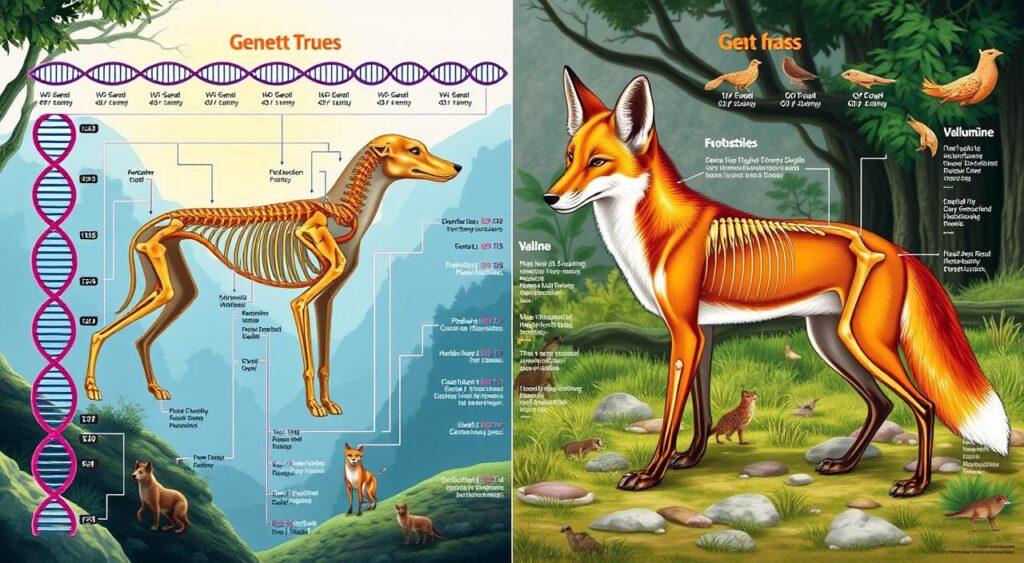
Genus Canis vs Genus Vulpes
Dogs (Canis familiaris) are part of the genus Canis. This group includes wolves, coyotes, and jackals. Most foxes, like the red fox (Vulpes vulpes), belong to the genus Vulpes.
Species in the same genus are more likely to interbreed. The species compatibility is higher within a genus. Some exceptions exist, like the Pampas fox (Lycalopex gymnocercus) from South America.
| Genus | Number of Species | Examples |
|---|---|---|
| Canis | 7 | Dogs, wolves, coyotes, jackals |
| Vulpes | 12 | Red fox, Arctic fox, kit fox |
| Lycalopex | 6 | Pampas fox, culpeo fox |
Chromosome Differences in Dogs and Foxes
Chromosomal compatibility is crucial for successful interbreeding. Dogs have 78 chromosomes (39 pairs). Foxes have different numbers depending on the species.
Red foxes have 34 chromosomes (17 pairs). Pampas foxes have 74 chromosomes (37 pairs). These differences create genetic barriers to producing viable offspring.
Mismatched chromosome numbers cause problems during meiosis. This leads to issues in developing potential dog-fox hybrid embryos. These barriers make interbreeding between dogs and foxes highly unlikely.
Genetic Barriers to Interbreeding
Genetic barriers stop domestic dogs and wild foxes from breeding successfully. These obstacles stem from their different taxonomic groups. The two species also have big differences in their chromosomes.
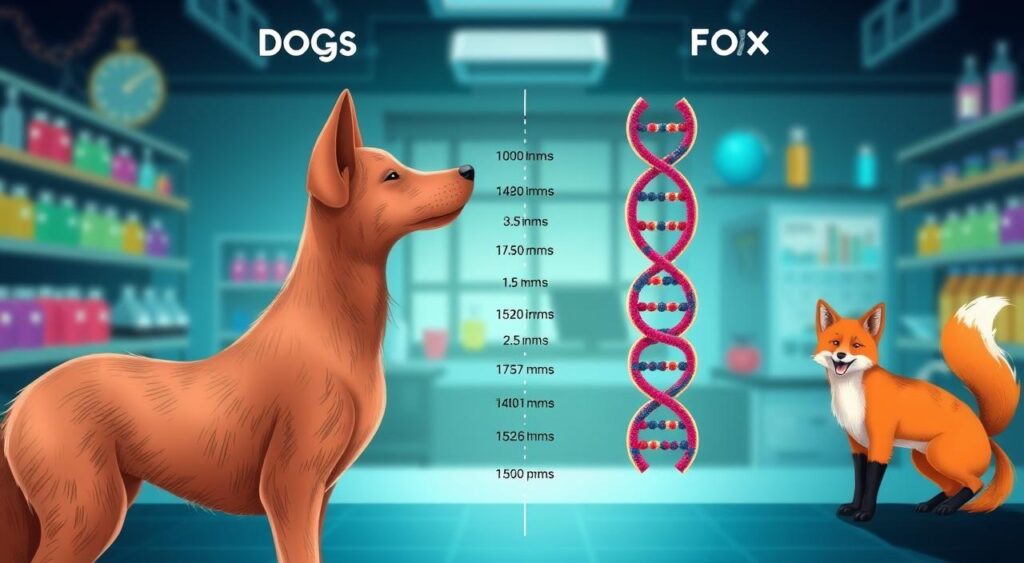
Dogs have 78 chromosomes, while red foxes have only 38. This big difference makes it hard for them to breed. Animals that can breed usually have similar chromosome counts.
Chromosomal Incompatibility
Different chromosome numbers can cause problems when forming gametes and embryos. This often leads to genetic issues or infertility. Sometimes, the offspring might not even survive.
The table below shows the chromosome counts for different canine species:
| Species | Chromosome Count |
|---|---|
| Domestic Dog (Canis lupus familiaris) | 78 |
| Gray Wolf (Canis lupus) | 78 |
| Coyote (Canis latrans) | 78 |
| Red Fox (Vulpes vulpes) | 38 |
Species in the Canis genus have 78 chromosomes. This includes dogs, wolves, and coyotes. They can breed with each other.
But red foxes, from the Vulpes genus, have only 38 chromosomes. This makes breeding with dogs very unlikely.
Evolutionary Divergence and Reproductive Isolation
Dogs and foxes split about 6.7 million years ago. This long separation led to big genetic differences. It also caused changes in behaviour and body functions.
The genetic difference between dogs and foxes is around 8%. This is much higher than between humans and apes. It makes breeding between dogs and foxes very unlikely.
Science is key when looking at breeding between different species. The India Veterinary Community’s disclaimer stresses this point.
There are rare claims of dog-fox hybrids, like the dogxim. But these lack scientific proof. The genetic barriers make such breeding highly unlikely.
Myths and Misconceptions About Dog-Fox Hybrids
Dog-fox hybrids have sparked many myths and misconceptions. These crossbreeds are extremely rare, if not impossible. Significant genetic and reproductive barriers prevent successful interspecies hybridization between dogs and foxes.
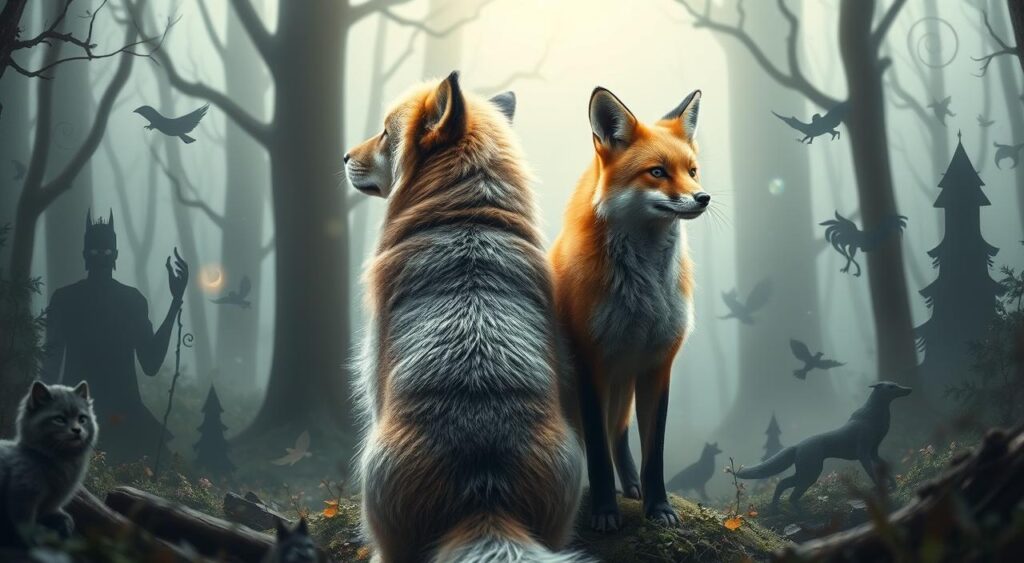
Some believe “doxes” are common or easily bred. However, no genetically verified cases exist. Anecdotal reports lack scientific proof and should be questioned.
Genetic differences make dog-fox hybrids unlikely. Dogs have 78 chromosomes, while foxes have 34. This chromosomal mismatch prevents successful mating.
Hybrids are viable when parent species have similar chromosome counts. Dogs can mate with wolves, dingoes, jackals, and coyotes. These animals are genetically closer to dogs than foxes.
| Species | Chromosome Count | Successful Hybridization with Dogs |
|---|---|---|
| Dog | 78 | N/A |
| Wolf | 78 | Yes |
| Dingo | 78 | Yes |
| Jackal | 78 | Yes |
| Coyote | 78 | Yes |
| Fox | 34 | Extremely Rare |
Some think dog-fox hybrids would show hybrid vigor. This idea is speculative due to genetic hurdles. Mismatched chromosomes likely cause infertility in any offspring.
In 2021, a potential dog-fox hybrid named Dogxim was found in Brazil. Dogxim has 76 chromosomes, between dogs and pampas foxes. This case remains exceptional and rare.
Scientific facts often clash with myths about dog-fox hybrids. Genetic differences and chromosomal incompatibility make these hybrids extremely unlikely. Understanding these limitations helps separate fact from fiction in animal hybridization.
Can Dogs Breed with Foxes? The Scientific Perspective
Dogs and foxes breeding is highly unlikely. They’ve evolved separately for millions of years, creating big genetic differences. There’s no solid proof of dog-fox hybrids in the wild or in captivity.
Lack of Documented Cases in the Wild
Scientists doubt dog-fox hybrids exist due to lack of proof. No claims of these offspring have been backed by evidence. This suggests strong genetic barriers between dogs and foxes in nature.
Challenges in Captive Breeding Attempts
Breeding dogs with foxes in captivity faces many obstacles. Dogs have 78 chromosomes, while red foxes have only 34. This makes it hard for them to produce viable offspring.
Foxes and dogs have different social structures and mating behaviors. These differences can cause problems in mating and raising hybrid offspring. This makes successful breeding even more difficult.
| Species | Chromosome Number | Genus |
|---|---|---|
| Domestic Dog | 78 | Canis |
| Red Fox | 34 | Vulpes |
| Fennec Fox | 64 | Vulpes |
| Raccoon Dog | 42 | Nyctereutes |
This table shows the big differences in chromosome numbers among canid species. It highlights the genetic barriers between dogs and foxes. Hybridization is rare even within the same genus.
Science remains doubtful about dogs breeding with foxes. Wild cases are undocumented, and captive attempts face many hurdles. The genetic and behavioral gaps between them are likely too wide to bridge.
The Rare Case of Dogxim: A Possible Dog-Fox Hybrid
A unique animal named Dogxim was found in southern Brazil in 2021. This discovery challenges our understanding of canine genetics and species compatibility. Dogxim suggests the possibility of a rare dog-fox hybrid.
Discovery and Genetic Testing of Dogxim
Dogxim’s discovery was groundbreaking in canine genetics. Geneticists from two Brazilian universities conducted extensive DNA tests on Dogxim. The results confirmed Dogxim was the offspring of a female Pampas fox and a male domestic dog.
Genetic testing revealed Dogxim had 76 chromosomes. This number falls between domestic dogs (78) and Pampas foxes (74). This finding solidified Dogxim’s hybrid status and raised questions about genetic barriers.
| Species | Number of Chromosomes |
|---|---|
| Domestic Dog | 78 |
| Pampas Fox | 74 |
| Dogxim (Dog-Fox Hybrid) | 76 |
Implications of the Dogxim Case
Dogxim challenges beliefs about canine evolution and reproductive barriers between species. This rare occurrence highlights increasing contact between wild and domestic species. It’s possibly due to human encroachment on natural habitats.
Dogxim’s case reminds us of complex interactions between species. It also shows potential consequences of hybridization. This discovery raises concerns about human activities impacting wildlife populations.
Hybridization can be a survival tactic in nature. It can also warn of environmental issues caused by human interference. Dogxim’s case emphasizes the need for more research on species interactions.
We must preserve natural habitats and minimize human impact on wildlife. Understanding dog-fox interactions and hybridization consequences is crucial. This knowledge can help develop strategies to protect canine populations.
Factors Contributing to Potential Dog-Fox Interactions
Habitat loss and human expansion have sparked concerns for wildlife conservation. This development increases the chances of domestic dogs and wild foxes interacting. As their territories overlap, the risk of interbreeding between these species may grow.
Habitat Loss and Overlapping Territories
Habitat loss is a key factor in dog-fox interactions. Foxes must adapt as natural areas become urban or agricultural landscapes. This often leads to overlap with areas where domestic dogs live.
Human settlements expanding into wild areas worsen this issue. People moving to new regions bring their pet dogs, increasing the chances of dog-fox encounters.
Abandoned Dogs in Natural Areas
Abandoning domestic dogs in natural areas also contributes to dog-fox interactions. Some irresponsible owners release unwanted dogs into the wild. These dogs struggle to survive alone and may seek out foxes for companionship.
Feral dog populations in fox habitats raise the risk of interbreeding. Abandoned dogs might form packs in areas where foxes live. This leads to more contact and possible hybridization.
To reduce these risks, we must encourage responsible pet ownership. Discouraging dog abandonment in natural areas is crucial. Conservation efforts should focus on protecting fox habitats.
Addressing these factors helps maintain genetic integrity for both species. It also promotes the long-term survival of wild fox populations.
Consequences of Potential Dog-Fox Hybridization
Dog-fox hybridization can harm fox populations. It may introduce genetic weaknesses and diseases, risking their survival. Crossbreeding can cause fertility issues and reduced adaptability in the wild.
Hybrids like the dogxim face unique challenges. This cross between a pampas fox and a dog has 76 chromosomes. The difference can lead to fertility issues in future generations.
Hybrids can dilute species-specific traits in wild populations. This may lead to a loss of biodiversity over time. A recent study shows interbreeding is common in plants and animals.
Physical anomalies are common in hybrids. These affect skull structure, dental features, and overall morphology. Such issues can hinder the hybrid’s survival in the wild.
| Species | Chromosome Count |
|---|---|
| Domestic Dog | 78 |
| Pampas Fox | 74 |
| Dog-Fox Hybrid (Dogxim) | 76 |
Human settlements encroach on wild habitats. This increases the chance of domestic dogs meeting wild canids. Such encounters raise the risk of hybridization events.
We must maintain the genetic integrity of canid populations. This means preventing domestic dogs from entering natural areas. It also requires protecting wild fox habitats and populations.
Domestication Experiments: The Russian Farm-Fox Experiment
A captivating experiment began in Russia in the 1950s. It aimed to study how wolves became dogs using silver foxes. The study has been running for 59 years since 1959.
Selective Breeding for Tameness in Silver Foxes
The experiment started with 30 male foxes and 100 vixens from fur farms. Only the tamest foxes were chosen to breed. Less than 20% of foxes could reproduce each generation.
Results and Implications of the Domestication Experiment
Over time, the bred foxes changed in behavior and looks. This showed the power of selective breeding and domestication.
| Generation | Observed Changes |
|---|---|
| 6th generation | Domesticated foxes became friendly, displaying behaviors like licking hands, being petted, whining when humans left, and wagging their tails. |
| 10th generation | Appearance of traits like floppy ears, piebald coloration, and a white “star patch.” |
| 15th generation | Stress hormone levels of domesticated foxes were approximately half that of wild foxes. |
| 30th generation | 70% to 80% of the selected foxes were classified as “elite” in terms of their tameness and friendliness towards humans. |
Within a decade, the foxes showed signs of domestication. They had floppy ears, curly tails, and lower stress hormone levels. Their fur became mottled and their faces looked more youthful.
The first big change was lower adrenaline after 8-10 generations. Female foxes’ breeding cycles also changed. They began earlier than usual.
Gene studies showed differences between tame and wild foxes. Changes were seen in serotonin receptor genes. The neural crest cell theory explains many of the changes seen.
This experiment shows how breeding affects animal behavior and bodies. It helps us understand how animals became domesticated over time. The study didn’t mix dogs and foxes, but it still taught us a lot.
Conservation Concerns and Future Research
Dog-fox hybridization poses risks to wildlife conservation efforts. It can harm the genetic makeup of wild fox populations. This may weaken their ability to survive in nature.
Future research should focus on canid genetics and factors leading to animal hybridization. Scientists can then develop strategies to protect wild foxes. This will help maintain species barriers and genetic integrity.
Key points to consider regarding the conservation of red foxes in Australia:
- Red foxes have successfully adapted to various Australian ecosystems and landscapes since their introduction.
- Fox predation has been identified as a key threatening process in New South Wales, contributing to the extinction of several native species.
- Fox populations in different regions of NSW vary in density, ranging from 1 fox per km² in coastal forests to 12 foxes per km² in urban areas.
- While diseases and predators influence fox population control, targeted control programs lead to the most significant mortality.
Monitoring wild fox populations is vital. It helps us understand interspecies hybridization and its impact. Regular surveys and genetic tests can track changes in fox populations.
These studies can spot areas where hybridization might occur. They also assess the health of fox populations.
| Region | Fox Density (per km²) |
|---|---|
| Coastal forests | 1 |
| Semi-arid and sub-alpine regions | 2 to 5 |
| Temperate grazing lands | 6 to 8 |
| Peri-urban and urban areas | Up to 12 |
We need strategies to reduce hybridization’s impact on fox conservation. This could involve creating protected areas for fox populations. Educating people about responsible pet ownership is also important.
Research on canid genetics and interspecies hybridization is crucial. It helps ensure wild fox populations survive long-term. Scientists, conservationists, and policymakers must work together to protect these important species.
Conclusion
Dogs and foxes share a common ancestor but can’t breed together. The scientific community firmly states this due to genetic barriers and evolutionary differences. Dogxim, a possible dog-fox hybrid, remains an unusual case.
The Russian Farm-Fox Experiment studied fox domestication through selective breeding. It showed foxes could develop dog-like traits over generations. However, this study didn’t involve breeding dogs with foxes.
The experiment’s findings help us understand domestic animal evolution and genetics in behavior. But they don’t support the idea of dog-fox hybrids.
Habitat loss and human encroachment affect wildlife populations. It’s vital to protect both domestic dogs and wild foxes. We should respect natural boundaries between species.
Promoting responsible pet ownership is key to maintaining ecological balance. It also prevents issues from interspecies interactions. More research will reveal the complex world of canid genetics.

